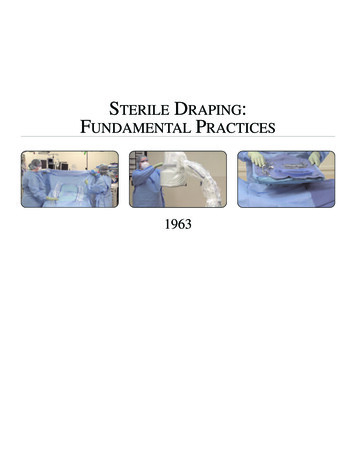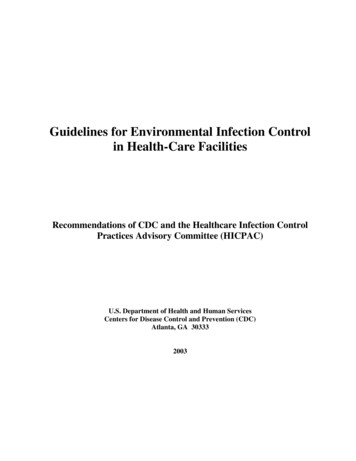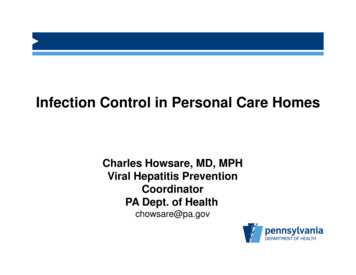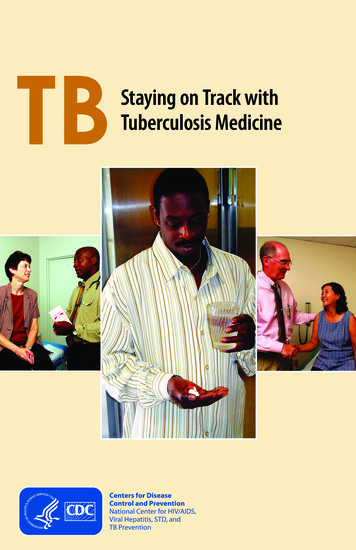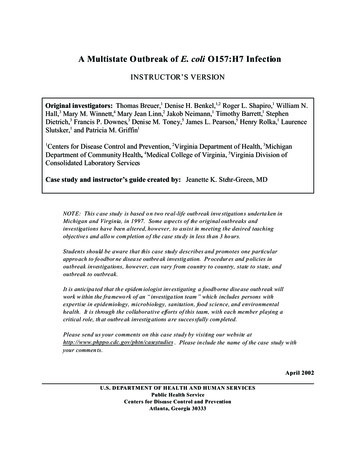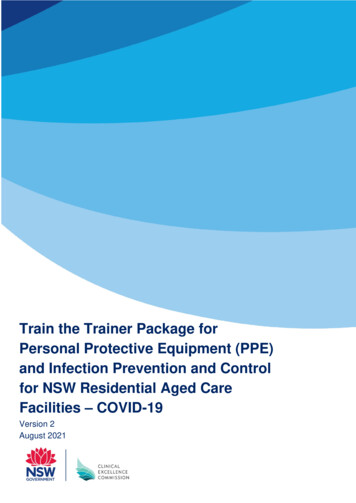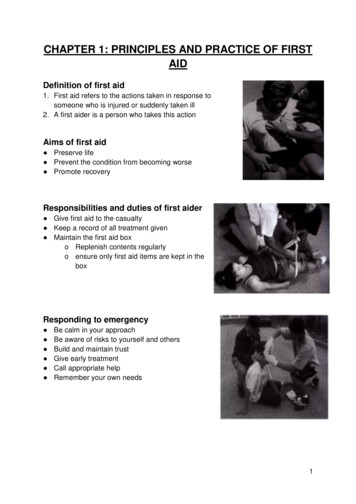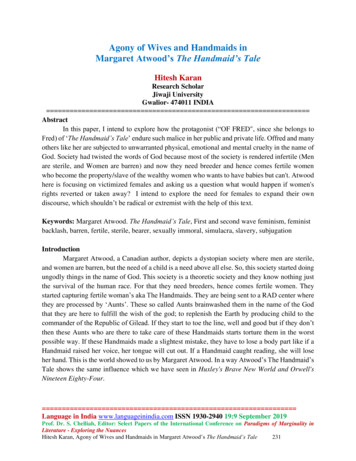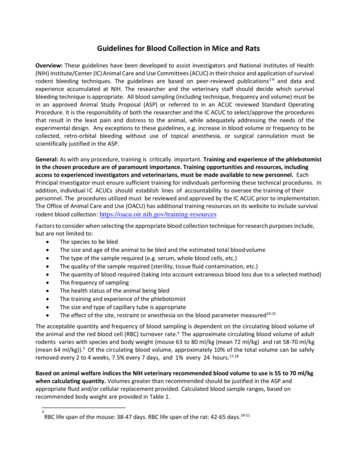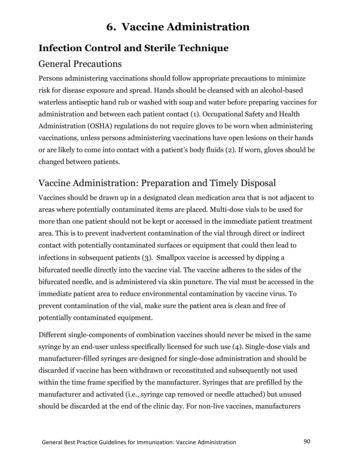
Transcription
6. Vaccine AdministrationInfection Control and Sterile TechniqueGeneral PrecautionsPersons administering vaccinations should follow appropriate precautions to minimizerisk for disease exposure and spread. Hands should be cleansed with an alcohol-basedwaterless antiseptic hand rub or washed with soap and water before preparing vaccines foradministration and between each patient contact (1). Occupational Safety and HealthAdministration (OSHA) regulations do not require gloves to be worn when administeringvaccinations, unless persons administering vaccinations have open lesions on their handsor are likely to come into contact with a patient’s body fluids (2). If worn, gloves should bechanged between patients.Vaccine Administration: Preparation and Timely DisposalVaccines should be drawn up in a designated clean medication area that is not adjacent toareas where potentially contaminated items are placed. Multi-dose vials to be used formore than one patient should not be kept or accessed in the immediate patient treatmentarea. This is to prevent inadvertent contamination of the vial through direct or indirectcontact with potentially contaminated surfaces or equipment that could then lead toinfections in subsequent patients (3). Smallpox vaccine is accessed by dipping abifurcated needle directly into the vaccine vial. The vaccine adheres to the sides of thebifurcated needle, and is administered via skin puncture. The vial must be accessed in theimmediate patient area to reduce environmental contamination by vaccine virus. Toprevent contamination of the vial, make sure the patient area is clean and free ofpotentially contaminated equipment.Different single-components of combination vaccines should never be mixed in the samesyringe by an end-user unless specifically licensed for such use (4). Single-dose vials andmanufacturer-filled syringes are designed for single-dose administration and should bediscarded if vaccine has been withdrawn or reconstituted and subsequently not usedwithin the time frame specified by the manufacturer. Syringes that are prefilled by themanufacturer and activated (i.e., syringe cap removed or needle attached) but unusedshould be discarded at the end of the clinic day. For non-live vaccines, manufacturersGeneral Best Practice Guidelines for Immunization: Vaccine Administration90
typically recommend use within the same day that a vaccine is withdrawn or reconstituted.For live vaccines that require reconstitution, manufacturers typically recommend thevaccine be used as soon as possible after reconstitution and be discarded if not used within30 minutes after reconstitution. For example, varicella vaccine should be discarded if notused within 30 minutes after reconstitution, whereas MMR vaccine, once reconstituted,must be kept in a dark place at 36 F to 46 F (2 C to 8 C) and should be discarded within 8hours if not used. When in doubt about the appropriate handling of a vaccine, vaccinationproviders should contact that vaccine’s manufacturer.ACIP discourages the routine practice of providers’ prefilling syringes for several reasons.Because the majority of vaccines have a similar appearance after being drawn into asyringe, prefilling might result in administration errors. Because unused prefilled syringesalso typically must be discarded if not used within the same day that they are filled,vaccine wastage might occur. The FDA does not license administration syringes forvaccine storage.In certain circumstances in which a single vaccine type is being used (e.g., in preparationfor a community influenza vaccination campaign), filling a small number (10 or fewer) ofsyringes may be considered (5). The doses should be administered as soon as possibleafter filling, by the same person who filled the syringes. Unused syringes that are prefilledby the manufacturer and activated (i.e., syringe cap removed or needle attached) should bediscarded at the end of the clinic day. Vaccine from two or more vials should never becombined to make one or more doses. This can lead to violation of expiration dates andproduct contamination (6,7).Health Care Provider Exposure to Vaccine ComponentsProviders are sometimes concerned when they have the same contraindications orprecautions as their patients from whom they withhold or defer vaccine. Foradministration of routinely recommended vaccines, there is no evidence of risk ofexposure of vaccine components to the health care provider, so conditions in the providerlabeled as contraindications and precautions to a vaccine components are not a reason towithdraw from this function of administering the vaccine to someone else. Historicconcerns about exposure to vaccine components are limited to non-parenteral vaccines inwhich some degree of environmental exposure is unavoidable (5, 8), or situations in whichGeneral Best Practice Guidelines for Immunization: Vaccine Administration91
self-inoculation is likely due to the nature of the vaccine microbe [e.g. reduced attenuationof smallpox vaccine virus (9)]. Persons administering ACAM 2000 smallpox vaccine tolaboratory and health care personnel at risk for occupational exposure to orthopoxvirusescan decrease the risk for inadvertent infection through recommended infection preventionmeasures. However, because of a theoretical risk for infection, vaccination withACAM2000 can be offered to health care personnel administering this vaccine, providedindividual persons have no specified contraindications to vaccination (10).Safe Use of Needles and SyringesNeedles and syringes used for vaccine injections must be sterile and disposable. A separateneedle and syringe should be used for each injection. Changing needles between drawingvaccine from a vial and injecting it into a recipient is not necessary unless the needle hasbeen damaged or contaminated (11).Bloodborne diseases (e.g., hepatitis B, hepatitis C, human immunodeficiency virus [HIV])are occupational hazards for clinicians and other health-care providers. The NeedlestickSafety and Prevention Act (2) was enacted in 2000 to reduce the incidence of needlestickinjury and the consequent risk for bloodborne diseases acquired from patients. The actdirected OSHA to strengthen its existing bloodborne pathogen standards. The revisedstandards became effective in 2001 (2). These federal regulations require the use ofengineering and work practice controls to eliminate or minimize employee exposure tobloodborne pathogens. Engineering controls means controls (e.g., sharps disposalcontainers, self-sheathing needles, safer medical devices, such as sharps with engineeredsharps injury protections and needleless systems) that isolate or remove the bloodbornepathogens hazard from the workplace). Needle-shielding or needle-free devices that mightsatisfy the occupational safety regulations for administering injectable vaccines areavailable in the United States (12-13). The regulations also require maintenance of recordsdocumenting injuries caused by needles and other medical sharp objects and thatnonmanagerial employees be involved in the evaluation and selection of safety-engineereddevices before they are procured. Additional information about implementation andenforcement of these regulations is available from OSHA.General Best Practice Guidelines for Immunization: Vaccine Administration92
To prevent inadvertent needlestick injury or reuse, safety mechanisms should be deployedafter use and needles and syringes should be discarded immediately in labeled, punctureproof containers located in the same room where the vaccine is administered (5). Usedneedles should never be recapped.Route of AdministrationInjectable RouteRoutes of administration are recommended by the manufacturer for each immunobiologic(Table 6-1). With the exceptions of bacille Calmette-Guérin (BCG) vaccine and smallpoxvaccine (administered intraepidermally), injectable vaccines are administered by theintramuscular or subcutaneous route. Deviation from the recommended route ofadministration might reduce vaccine efficacy (14-15) or increase the risk for local adversereactions (16-18).The method of administration of injectable vaccines is determined, in part, by theinclusion of adjuvants in some vaccines. An adjuvant is a vaccine component distinct fromthe antigen that enhances the immune response to the antigen, but might also increaserisk of adverse reactions. To decrease risk of local adverse events, non-live vaccinescontaining an adjuvant should be injected into a muscle. Administering a vaccinecontaining an adjuvant either subcutaneously or intradermally can cause local irritation,induration, skin discoloration, inflammation, and granuloma formation.Intramuscular InjectionsNeedle LengthInjectable immunobiologics should be administered where local, neural, vascular, or tissueinjury is unlikely. Use of longer needles has been associated with less redness or swellingthan occurs with shorter needles because of injection into deeper muscle mass (16).Appropriate needle length depends on age and body mass. Injection technique is the mostimportant parameter to ensure efficient intramuscular vaccine delivery.For all intramuscular injections, the needle should be long enough to reach the musclemass and prevent vaccine from seeping into subcutaneous tissue, but not so long as toinvolve underlying nerves, blood vessels, or bone (15,19-22). Vaccinators should befamiliar with the anatomy of the area into which they are injecting vaccine.General Best Practice Guidelines for Immunization: Vaccine Administration93
Intramuscular injections are administered at a 90-degree angle to the skin, preferably intothe anterolateral aspect of the thigh or the deltoid muscle of the upper arm, depending onthe age of the patient (Table 6-2).The needle gauge for intramuscular injection is 22-25 gauge. A decision on needle lengthand site of injection must be made for each person on the basis of the size of the muscle,the thickness of adipose tissue at the injection site, the volume of the material to beadministered, injection technique, and the depth below the muscle surface into which thematerial is to be injected (Figure 1). Some experts allow intramuscular injection with a ⅝inch needle but ONLY if the skin is stretched flat (21). If the subcutaneous and muscletissue are bunched to minimize the chance of striking bone (19), a 1-inch needle or largeris required to ensure intramuscular administration. Aspiration before injection of vaccinesor toxoids (i.e., pulling back on the syringe plunger after needle insertion but beforeinjection) is not necessary because no large blood vessels are present at the recommendedinjection sites, and a process that includes aspiration might be more painful for infants(22).Infants (Aged 12 Months)For the majority of infants, the anterolateral aspect of the thigh is the recommended sitefor injection because it provides comparatively larger muscle mass than the deltoid(Figure 2) (23). In certain circumstances (e.g., physical obstruction to other sites and noreasonable indication to defer doses), the gluteal muscle can be used. If the gluteal musclemust be used, care should be taken to define the anatomic landmarks.(a) For the majority ofinfants, a 1-inch needle is sufficient to penetrate the thigh muscle.Toddlers (Aged 12 Months-2 Years)For toddlers, the anterolateral thigh muscle is preferred, and when this site is used, theneedle should be at least 1 inch long. The deltoid muscle can be used if the muscle mass isadequate. If 2 vaccines are to be administered in a single limb, they should be spaced aninch apart (4, 24).Children (Aged 3-10 Years)The deltoid muscle is preferred for children aged 3-10 years (23); the needle length fordeltoid site injections can range from ⅝ to 1 inch on the basis of technique. Theanterolateral thigh can also be used (25). In this case the needle length should be 1 inch to1.25 inches. Knowledge of body mass can be useful for estimating the appropriate needlelength (26).General Best Practice Guidelines for Immunization: Vaccine Administration94
Young Adolescents (Aged 11-18 years)The deltoid muscle is preferred for adolescents 11-18 years of age. The anterolateral thighcan also be used. For injection into the anterolateral thigh, most adolescents will require a1-1.5-inch needle to ensure intramuscular administration (27).Adults (Aged 19 Years)For adults, the deltoid muscle is recommended for routine intramuscular vaccinations(23) (Figure 3). The anterolateral thigh also can be used. When injecting into the deltoidmuscle, for adults a measurement of body mass/weight is allowable prior to vaccination,understanding that resources to measure body mass/weight are not available in all clinicalsettings. For men and women who weigh 130 lbs ( 60 kg), a ⅝-inch needle is sufficientto ensure intramuscular injection in the deltoid muscle if the injection is made at a 90degree angle and the tissue is not bunched. For men and women who weigh 130-152 lbs(60-70 kg), a 1-inch needle is sufficient. For women who weigh 152-200 lbs (70-90 kg) andmen who weigh 152-260 lbs (70-118 kg), a 1- to 1.5-inch needle is recommended. Forwomen who weigh 200 lbs ( 90 kg) or men who weigh 260 lbs ( 118 kg), a 1.5-inchneedle is recommended (table 6-2) (20). For injection into the anterolateral thigh muscle,a 1.5-inch needle should be used, although a 1-inch needle may be used if the skin isstretched tightly and subcutaneous tissues are not bunched.Subcutaneous InjectionsSubcutaneous injections are administered at a 45-degree angle, usually into the thigh forinfants aged 12 months and in the upper-outer triceps area of persons aged 12 months.Subcutaneous injections may be administered into the upper-outer triceps area of aninfant if necessary. A ⅝-inch, 23- to 25-gauge needle should be inserted into thesubcutaneous tissue (Figures 4 and 5) (4).Oral RouteRotavirus, adenovirus, cholera vaccine, and oral typhoid vaccines are the only vaccinesadministered orally in the United States. Oral typhoid capsules should be administered asdirected by the manufacturer. The capsules should not be opened or mixed with any othersubstance. Rotavirus vaccines are licensed for infants. There are 2 brands of rotavirusvaccine, and they have different types of applicators. Providers should consult packageinserts for details.General Best Practice Guidelines for Immunization: Vaccine Administration95
Intranasal RouteLive attenuated influenza vaccine is approved for healthy nonpregnant persons aged 2-49years and is the only vaccine administered by the intranasal route. The administrationdevice is a nasal sprayer with a dose-divider clip that allows introduction of one 0.1-mLspray into each naris. The tip should be inserted slightly into the naris beforeadministration. Even if the person coughs or sneezes immediately after administration orthe dose is expelled any other way, the vaccine dose need not be repeated (5).Severely immunosuppressed persons (i.e., those who require care in a protectedenvironment, e.g., bone marrow transplant recipients, individuals with severe combinedimmunodeficiency diseases) should not administer LAIV. It would be uncommon forpersons with these conditions to be in a role administering vaccines. Other persons atincreased risk for influenza complications can administer LAIV. These include personswith underlying medical conditions placing them at higher risk or who are likely to be atrisk, including pregnant women, persons with asthma, and persons aged 50 years (2).Multiple InjectionsIf multiple vaccines are administered at a single visit, administer each preparation at adifferent anatomic site (28). The location of all injection sites with the correspondingvaccine injected should be documented in each patient’s medical record. Health-carepractices should consider using a vaccination site map so that all persons administeringvaccines routinely use a particular anatomic site for each particular vaccine.For infants and younger children, if more than 2 vaccines are injected in a single limb, thethigh is the preferred site because of the greater muscle mass; the injections should besufficiently separated (separate anatomic sites [i.e. 1 inch] if possible) so that any localreactions can be differentiated (13,29). For older children and adults, the deltoid musclecan be used for more than one intramuscular injection.If a vaccine and an immune globulin preparation are administered simultaneously (e.g.,Td/Tdap and tetanus immune globulin [TIG], hepatitis B and hepatitis B immunoglobulin[HBIG]), separate limbs should be used for each injection (29-30).General Best Practice Guidelines for Immunization: Vaccine Administration96
Jet InjectionsJet injectors are needle-free devices that pressurize liquid medication, forcing it through anozzle orifice into a narrow stream capable of penetrating skin to deliver a drug or vaccineinto intradermal, subcutaneous, or intramuscular tissues (32-33). Immune responsesgenerated by jet injectors against both attenuated and non-live viral and bacterial antigensare usually equivalent to, and occasionally greater than, immune responses induced byneedle injection. However, local reactions or injuries (e.g., skin laceration, transientneuropathy, hematoma) are sometimes more frequent on delivery of vaccine by jetinjectors compared with needle injection, depending on the inherent irritability of thevaccine and operator technique (33).Multiple use jet injectors using the same nozzle for consecutive injections withoutintervening sterilization were used in mass vaccination campaigns from the 1950s throughthe 1990s (33); however, these were found to be unsafe because of the possibility ofbloodborne pathogen transmission (34-37) and should not be used. A new generation ofjet injectors with disposable cartridges and syringes has been developed since the 1990s.With a new, sterile dose chamber and nozzle for each patient and correct use, thesedevices do not have the same safety concerns as multiple-use nozzle jet injectors. Severalof the newer devices have been approved by FDA for use with specific vaccines (33). Jetinjectors prevent needlestick injuries to health-care providers (2) and can overcomeimproper, unsterile reuse and other drawbacks of needles and syringes in developingcountries (9, 38-39).Methods for Alleviating Discomfort and Pain Associatedwith VaccinationComfort measures, such as distraction (e.g., playing music or pretending to blow away thepain), cooling of the injection site(s), topical analgesia, ingestion of sweet liquids,breastfeeding, swaddling, and slow, lateral swaying can help infants or children cope withthe discomfort associated with vaccination (40-42). Pretreatment (30-60 minutes beforeinjection) with a 5% topical lidocaine-prilocaine emulsion might decrease the pain ofvaccination by causing superficial anesthesia (43-44). Evidence indicates that this creamdoes not interfere with the immune response to MMR (45). There is no evidence the creaminterferes with other vaccines (46-49).General Best Practice Guidelines for Immunization: Vaccine Administration97
Topical lidocaine-prilocaine emulsion should not be used on infants aged 12 months whoare receiving treatment with methemoglobin-inducing agents (e.g., acetaminophen, amylnitrate, nitroprusside, dapsone) because of the possible development ofmethemoglobinemia (50). Use of a topical refrigerant (vapocoolant) spray immediatelybefore vaccination can reduce the short-term pain associated with injections and can be aseffective as lidocaine-prilocaine cream (51).Evidence does not support use of antipyretics before or at the time of vaccination;however, they can be used for the treatment of fever and local discomfort that might occurfollowing vaccination. Studies of children with previous febrile seizures have notdemonstrated antipyretics to be effective in the prevention of febrile seizures (48).Clinical Implications of Nonstandard VaccinationPracticesBest practice guidance for route, site, and dosage of immunobiologics is derived from datafrom clinical trials, practical experience, normal intervals of health care visits, andtheoretical considerations. ACIP discourages variations from the recommended route, site,volume, or number of doses of any vaccine.Variation from the recommended route and site can result in inadequate protection. Inadults (but not in infants) (52), the immunogenicity of hepatitis B is substantially lowerwhen the gluteal rather than the deltoid site is used for administration (8). Hepatitis Badministered intradermally might result in a lower seroconversion rate and final titer ofhepatitis B surface antibody than when administered by the deltoid intramuscular route(53-54). Hepatitis B administered by any route other than intramuscular, or in adults atany site other than the deltoid or anterolateral thigh, should not be counted as valid andshould be repeated (9). Similarly, doses of rabies vaccine administered in the gluteal siteshould not be counted as valid doses and should be repeated (54). Hepatitis A vaccine andmeningococcal conjugate vaccine do not need to be repeated if administered by thesubcutaneous route (55-56). However, for DTaP, Hib, and PCV13, there is no evidencerelated to immunogenicity of these 3 vaccines given subcutaneously. Providers shouldaddress circumstances in which dose(s) of these vaccines have been administeredsubcutaneously on a case-by-case basis.General Best Practice Guidelines for Immunization: Vaccine Administration98
Inactivated influenza vaccine is immunogenic when administered in a lower-thanstandard dose by the intradermal route to healthy adult volunteers. Intradermal injectionproduced antibody responses similar to intramuscular injection in vaccinees aged 18-60years (57). However, the immunogenicity for persons aged 65 years is inadequate, andvarying the recommended route and dose either with the intradermal product licensedthrough 64 years of age or with other influenza vaccines is not recommended (24).Live, attenuated injectable vaccines (e.g., MMR, varicella, yellow fever) and certain nonlive vaccines (e.g., meningococcal polysaccharide) are recommended by the manufacturersto be administered by subcutaneous injection. PPSV23and IPV are recommended by themanufacturer to be administered by the subcutaneous or intramuscular route. Responseto vaccines recommended by the subcutaneous route is unlikely to be affected if thevaccines are administered by the intramuscular rather than subcutaneous route.Repeating doses of vaccine administered by the intramuscular route when recommendedto be by the subcutaneous route is not necessary (10).Administering volumes smaller than recommended (e.g., inappropriately divided doses)might result in inadequate protection. Using reduced doses administered at multiplevaccination visits that equal a full dose or using smaller divided doses is not recommended(4). Any vaccination using less than the standard dose should not be counted, and theperson should be revaccinated according to age unless serologic testing indicates that anadequate response has developed. However, if 2 half-volume formulations of vaccine havealready been administered on the same clinic day to a patient recommended for the fullvolume formulation, these 2 doses can count as one full dose. If less than a fullrecommended dose of a vaccine is administered because of syringe, applicator, or needleleakage, the dose should be repeated (5). Using larger-than-recommended dosages can behazardous because of excessive local or systemic concentrations of antigens or othervaccine constituents.(a)If the gluteal muscle is chosen, injection should be administered lateral and superior to a line between the posterior superior iliacspine and the greater trochanter or in the ventrogluteal site, the center of a triangle bounded by the anterior superior iliac spine, thetubercle of the iliac crest, and the upper border of the greater trochanter.General Best Practice Guidelines for Immunization: Vaccine Administration99
TABLE 6-1. Dose and route of administration for selected vaccinesVaccineDoseRouteDEN4CYD0.5 mLSubcutDTaP, DT, Td, Tdap0.5 mLIMDTaP-HepB-IPV0.5 mLIMDTaP/Hib0.5 mLIMDTaP-IPV/Hib0.5 mLIMDTaP-IPV0.5 mLIMHib0.5 mLIMHib-MenCY0.5 mLIMHepA 18 years: 0.5 mL 19 years: 1.0 mLIMHepB 19 years: 0.5 mL(a) 20 years: 1.0 mLIMHepA-HepB 18 years: 1.0 mLIMLAIV0.2 mL divided dose betweennaresIntranasal sprayIIV6-35 months: 0.25 mL or 0.5 mL IM 3 years: 0.5 mL(b)MenB0.5 mLIMMMR0.5 mLSubcutMMRV0.5 mLSubcutMenACWY0.5 mLIMMPSV40.5 mLSubcutPCV130.5 mLIMPPSV230.5 mLIM or SubcutHPV0.5 mLIMIPV0.5 mLIM or SubcutRotavirus (RV1 or RV5)(1.0 mL or 2.0 mL)OralVaricella0.5 mLSubcutRZV0.5 mL(c)IMAbbreviations: DEN4CYD dengue vaccine; DT diphtheria and tetanus toxoids; DTaP diphtheria and tetanustoxoids and acellular pertussis; HepA hepatitis A; HepB hepatitis B; Hib Haemophilus influenzae type b; HPV human papillomavirus; IIV inactivated influenza vaccine; IM intramuscular; IPV inactivated poliovirus; LAIV live, attenuated influenza vaccine; MenACWY quadrivalent meningococcal conjugate vaccine; MenCY bivalentmeningococcal conjugate vaccine component; MMR measles, mumps, and rubella; MMRV measles, mumps,rubella, and varicella; MPSV4 quadrivalent meningococcal polysaccharide vaccine; PCV13 pneumococcalconjugate vaccine; PPSV23 pneumococcal polysaccharide vaccine; RV1 live, attenuated monovalent rotavirusGeneral Best Practice Guidelines for Immunization: Vaccine Administration100
TABLE 6-1. Dose and route of administration for selected vaccinesVaccineDoseRoutevaccine; RV5 live, reassortment pentavalent rotavirus vaccine; RZV recombinant adjuvanted zoster vaccine;Subcut subcutaneous; Td tetanus and diphtheria toxoids; Tdap tetanus toxoid, reduced diphtheria toxoid, andacellular pertussis.Source: Adapted from Immunization Action Coalition: http://www.immunize.org.(a) Persons aged 11-15 years may be administered Recombivax HB (Merck), 1.0 mL (adult formulation) on a 2-dose schedule.(b) Note that prefilled syringes of High-Dose Fluzone have a volume of 0.7 cc and the recommended volume of administration is0.7 ccs.Do not withdraw more than 0.5 mL from the reconstituted product, even if some product is left in the vial.General Best Practice Guidelines for Immunization: Vaccine Administration101
TABLE 6-2. Needle length and injection site of IM injections for childrenaged 18 years (by age) and adults aged 19 years (by sex and weight)Age groupNeedle lengthInjection siteNeonates(a)5/8 inch (16 mm)(b)Anterolateral thighInfants, 1-12 months1 inch (25 mm)Anterolateral thighToddlers, 1-2 years1-1.25 inch (25-32mm)Anterolateral thigh(c)5/8(b)-1 inch (16-25mm)Deltoid muscle of arm5/8(b)-1 inch (16-25mm)Deltoid muscle of arm(c)1-1.25 inches (25-32mm)Anterolateral thigh5/8(b)-1 inch (16-25mm)Deltoid muscle of arm(c)1-1.5 inches (25-38mm)Anterolateral thighMen and women, 60 kg (130 lbs)1 inch (25 mm) (d)Deltoid muscle of armMen and women, 60-70 kg (130152 lbs)1 inch (25 mm)Men, 70-118 kg (152-260 lbs)1-1.5 inches (25-38mm)Children (birth-18 years)Children, 3-10 yearsChildren, 11-18 yearsAdults ( 19 years)Women, 70-90 kg (152-200 lbs)Men, 118 kg (260 lbs)1.5 inches (38 mm)Women, 90 kg (200 lbs)Men and women, any weight1.5 inches (38 mm)(e)Anterolateral thighGeneral Best Practice Guidelines for Immunization: Vaccine Administration102
Abbreviation: IM intramuscular.Source: (14).(a) First(b) If28 days of life.skin is stretched tightly and subcutaneous tissues are not bunched.(c) Preferredsite.(d) Someexperts recommend a 5/8-inch needle for men and women who weigh 60 kg, if used, skin must bestretched tightly (do not bunch subcutaneous tissue).(e) Some experts recommend a 1-inch needle if the skin is stretched tightly and subcutaneous tissues are notbunched.General Best Practice Guidelines for Immunization: Vaccine Administration103
Figure 1. Intramuscular needle insertionSource: Adapted from California Immunization Branch.Alternate Text: This drawing shows intramuscular needle insertion into a crosssection of skin. The needle is inserted at a 90-degree angle and penetrates the dermis,fatty tissue (subcutaneous), and muscle tissue.General Best Practice Guidelines for Immunization: Vaccine Administration104
Figure 2. Intramuscular/subcutaneous site of administration: anterolateralthighSource: Adapted from Minnesota Department of Health.Alternate Text: This drawing shows a mother holding an infant. The anterolateralaspect of the infant’s thigh is shaded, showing the proper site forintramuscular/subcutaneous vaccine administration.General Best Practice Guidelines for Immunization: Vaccine Administration105
Figure 3. Intramuscular site of administration: deltoidSource: Adapted from Minnesota Department of Health.Alternate Text: This line drawing is a side view of an adult. The deltoid muscle of thearm is shaded, showing the proper site for intramuscular vaccine administration.General Best Practice Guidelines for Immunization: Vaccine Administration106
Figure 4. Subcutaneous site of administration: tricepsSource: Adapted from the Minnesota Department of Health.Alternate Text: This line drawing is a rear/dorsal view of an adult. The triceps muscleof the arm is shaded, showing the proper site for subcutaneous vaccine administration.General Best Practice Guidelines for Immunization: Vaccine Administration107
Figure 5. Subcutaneous needle insertionSource: Adapted from California Immunization Branch.Alternate Text: This drawing shows subcutaneous needle insertion into a crosssection of skin. The needle is inserted at a 45-degree angle and penetrates the dermisand fatty tissue (subcutaneous) but not the muscle tissue.General Best Practice Guidelines for Immunization: Vaccine Administration108
REFERENCES1. Boyce JM, Pittet D. Guideline for hand hygiene i
needle and syringe should be used for each injection. Changing needles between drawing vaccine from a vial and injecting it into a recipient is not necessary unless the needle has been damaged or contaminated (11). Bloodborne diseases (e.g., hepatitis B, hepatitis C, human immunodeficiency virus [HIV])
